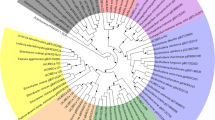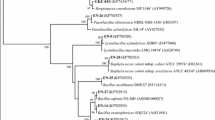Abstract
The effects of Bacillus sp. SLS18, a plant-growth-promoting endophyte, on the biomass production and Mn/Cd uptake of sweet sorghum (Sorghum bicolor L.), Phytolacca acinosa Roxb., and Solanum nigrum L. were investigated. SLS18 displayed multiple heavy metals and antibiotics resistances. The strain also exhibited the capacity of producing indole-3-acetic acid, siderophores, and 1-aminocyclopropane-1-carboxylic acid deaminase. In pot experiments, SLS18 could not only infect plants effectively but also significantly increase the biomass of the three tested plants in the presence of Mn/Cd. The promoting effect order of SLS18 on the biomass of the tested plants was sweet sorghum > P. acinosa > S. nigrum L. In the presence of Mn (2,000 mg kg−1) and Cd (50 mg kg−1) in vermiculite, the total Mn/Cd uptakes in the aerial parts of sweet sorghum, P. acinosa, and S. nigrum L. were increased by 65.2%/40.0%, 55.2%/31.1%, and 18.6%/25.6%, respectively, compared to the uninoculated controls. This demonstrates that the symbiont of SLS18 and sweet sorghum has the potential of improving sweet sorghum biomass production and its total metal uptake on heavy metal-polluted marginal land. It offers the potential that heavy metal-polluted marginal land could be utilized in planting sweet sorghum as biofuel feedstock for ethanol production, which not only gives a promising phytoremediation strategy but also eases the competition for limited fertile farmland between energy crops and food crops.

Similar content being viewed by others
References
Abou-Shanab RAI, Angle JS, Chaney RL (2006) Bacterial inoculants affecting nickel uptake by Alyssum murale from low, moderate and high Ni soils. Soil Biol Biochem 38:2882–2889
Araújo WL, Marcon J, Maccheroni W Jr, van Elsas JD, van Vuurde JWL, Azevedo JL (2002) Diversity of endophytic bacterial populations and their interaction with Xylella fastidiosa in citrus plants. Appl Environ Microbiol 68:4906–4914
Bennett AS, Anex RP (2009) Production, transportation and milling costs of sweet sorghum as a feedstock for centralized bioethanol production in the upper Midwest. Bioresource Technol 100:1595–1607
Burd GI, Dixon DG, Glick BR (2000) Plant growth-promoting bacteria that decrease heavy metal toxicity in plants. Can J Microbiol 46:237–245
Chen L, Luo SL, Xiao X, Guo HJ, Chen JL, Wan Y, Li B, Xu TY, Xi Q, Rao C, Liu CB, Zeng GM (2010) Application of plant growth-promoting endophytes (PGPE) isolated from Solanum nigrum L. for phytoextraction of Cd-polluted soils. Appl Soil Ecol 46:383–389
Compant S, Clément C, Sessitsch A (2010) Plant growth-promoting bacteria in the rhizo- and endosphere of plants: their role, colonization, mechanisms involved and prospects for utilization. Soil Biol Biochem 42:669–678
Corredor DY, Salazar JM, Hohn KL, Bean S, Bean B, Wang D (2009) Evaluation and characterization of forage sorghum as feedstock for fermentable sugar production. Appl Biochem Biotech 158:164–179
Dowling DN, Doty SL (2009) Improving phytoremediation through biotechnology. Curr Opin Biotechnol 20:204–206
Dworkin M, Foster JW (1958) Experiments with some microorganisms which utilize ethane and hydrogen. J Bacteriol 75:592–603
Epelde L, Mijangos I, Becerril JM, Garbisu C (2009) Soil microbial community as bioindicator of the recovery of soil functioning derived from metal phytoextraction with sorghum. Soil Biol Biochem 41:1788–1794
Evers A, Hancock RD, Martell AE, Motekaitis RJ (1989) Metal ion recognition in ligands with negatively charged oxygen donor groups. Complexation of iron(III), gallium(III), indium(III), aluminum(III), and other highly charged metal ions. Inorg Chem 28:2189–2195
Gerber GB, Léonard A, Hantson P (2002) Carcinogenicity, mutagenicity and teratogenicity of manganese compounds. Crit Rev Oncol Hematol 42:25–34
Glick BR (2010) Using soil bacteria to facilitate phytoremediation. Biotechnol Adv 28:367–374
Gordon SA, Weber RP (1951) Colorimetric estimation of indoleacetic acid. Plant Physiol 26:192–195
Hardoim PR, van Overbeek LS, van Elsas JD (2008) Properties of bacterial endophytes and their proposed role in plant growth. Trends Microbiol 16:463–471
Hoagland DR, Arnon DI (1950) The water culture method for growing plants without soil. Calif Agr Exp Sta Circ 347:1–32
Idris R, Trifonova R, Puschenreiter M, Wenzel WW, Sessitsch A (2004) Bacterial communities associated with flowering plants of the Ni hyperaccumulator Thaspi goesingense. Appl Environ Microbiol 70:2667–2677
Jasberg BK, Montgomery RR, Anderson RA (1983) Preservation of sweet sorghum biomass. Biotechnol Bioeng Symp 13:113–120
Jha P, Kumar A (2009) Characterization of novel plant growth promoting endophytic bacterium Achromobacter xylosoxidans from wheat plant. Microb Ecol 58:179–188
Jiang CY, Sheng XF, Qian M, Wang QY (2008) Isolation and characterization of a heavy metal-resistant Burkholderia sp. from heavy metal-contaminated paddy field soil and its potential in promoting plant growth and heavy metal accumulation in metal-polluted soil. Chemosphere 72:157–164
Krämer U (2005) Phytoremediation: novel approaches to cleaning up polluted soils. Curr Opin Biotech 16:133–141
Li BZ, Balan V, Yuan YJ, Dale BE (2010) Process optimization to convert forage and sweet sorghum bagasse to ethanol based on ammonia fiber expansion (AFEX) pretreatment. Bioresource Technol 101:1285–1292
Linton JA, Miller JC, Little RD, Petrolia DR, Coble KH (2011) Economic feasibility of producing sweet sorghum as an ethanol feedstock in the southeastern United States. Biomass Bioenerg 35:3050–3057
Ma Y, Prasad MNV, Rajkumar M, Freitas H (2011) Plant growth promoting rhizobacteria and endophytes accelerate phytoremediation of metalliferous soils. Biotechnol Adv 29:248–258
Mamma D, Christakopoulos P, Koullas D, Kekos D, Macris BJ, Koukios E (1995) An alternative approach to the bioconversion of sweet sorghum carbohydrates to ethanol. Biomass Bioenerg 8:99–103
Mastretta C, Taghavi S, van der Lelie D, Mengoni A, Galardi F, Gonnelli C, Barac T, Boulet J, Weyens N, Vangronsveld J (2009) Endophytic bacteria from seeds of Nicotiana tabacum can reduce cadmium phytotoxicity. Int J Phytoremediat 11:251–267
Penrose DM, Glick BR (2003) Methods for isolating and characterizing ACC deaminase-containing plant growth-promoting rhizobacteria. Physiol Plantarum 118:10–15
Rajkumar M, Ae N, Freitas H (2009) Endophytic bacteria and their potential to enhance heavy metal phytoextraction. Chemosphere 77:153–160
Rajkumar M, Nagendran R, Lee KJ, Lee WH, Kim SZ (2006) Influence of plant growth promoting bacteria and Cr6+ on the growth of Indian mustard. Chemosphere 62:741–748
Rubin EM (2008) Genomics of cellulosic biofuels. Nature 454:841–845
Schatz A, Bovell C Jr (1952) Growth and hydrogenase activity of a new bacterium, Hydrogenomonas facilis. J Bacteriol 63:87–98
Schwyn B, Neilands JB (1987) Universal chemical assay for the detection and determination of siderophores. Anal Biochem 160:47–56
Sheng XF, Xia JJ (2006) Improvement of rape (Brassica napus) plant growth and cadmium uptake by cadmium-resistant bacteria. Chemosphere 64:1036–1042
Sheng XF, He LY, Wang QY, Ye HS, Jiang CY (2008a) Effects of inoculation of biosurfactant-producing Bacillus sp. J119 on plant growth and cadmium uptake in a cadmium-amended soil. J Hazard Mater 155:17–22
Sheng XF, Xia JJ, Jiang CY, He LY, Qian M (2008b) Characterization of heavy metal-resistant endophytic bacteria from rape (Brassica napus) roots and their potential in promoting the growth and lead accumulation of rape. Environ Pollut 156:1164–1170
Shi YW, Lou K, Li C (2010) Growth and photosynthetic efficiency promotion of sugar beet (Beta vulgaris L.) by endophytic bacteria. Photosynth Res 105:5–13
Strobel GA (2003) Endophytes as sources of bioactive products. Microbes Infect 5:535–544
Taghavi S, Garafola C, Monchy S, Newman L, Hoffman A, Weyens N, Barac T, Vangronsveld J, van der Lelie D (2009) Genome survey and characterization of endophytic bacteria exhibiting a beneficial effect on growth and development of poplar trees. Appl Environ Microbiol 75:748–757
Tripathi M, Munot HP, Shouche Y, Meyer JM, Goel R (2005) Isolation and functional characterization of siderophore-producing lead- and cadmium-resistant Pseudomonas putida KNP9. Curr Microbiol 50:233–237
Vartanian JP, Sala M, Henry M, Wain-Hobson S, Meyerhans A (1999) Manganese cations increase the mutation rate of human immunodeficiency virus type 1 ex vivo. J Gen Virol 80:1983–1986
Weyens N, van der Lelie D, Taghavi S, Newman L, Vangronsveld J (2009a) Exploiting plant–microbe partnerships to improve biomass production and remediation. Trends Microbiol 27:591–598
Weyens N, van der Lelie D, Taghavi S, Vangronsveld J (2009b) Phytoremediation: plant–endophyte partnerships take the challenge. Curr Opin Biotech 20:248–254
Wu CH, Wood TK, Mulchandani A, Chen W (2006) Engineering plant–microbe symbiosis for rhizoremediation of heavy metals. Appl Environ Microbiol 72:1129–1134
Xue SG, Chen YX, Reeves RD, Baker AJM, Lin Q, Fernando DR (2004) Manganese uptake and accumulation by the hyperaccumulator plant Phytolacca acinosa Roxb. (Phytolaccaceae). Environ Pollut 131:393–399
Zhuang P, Shu WS, Li Z, Liao B, Li JL, Shao JS (2009) Removal of metals by sorghum plants from contaminated land. J Environ Sci 21:1432–1437
Acknowledgments
This work was financially supported by a grant from National Science Fund for Distinguished Young Scholars (no. 50725825), the Key Program of National Natural Science Foundation of China (no. 50830301), and Hunan Province Natural Science Foundation of China (no.10JJ5051).
Author information
Authors and Affiliations
Corresponding author
Rights and permissions
About this article
Cite this article
Luo, S., Xu, T., Chen, L. et al. Endophyte-assisted promotion of biomass production and metal-uptake of energy crop sweet sorghum by plant-growth-promoting endophyte Bacillus sp. SLS18. Appl Microbiol Biotechnol 93, 1745–1753 (2012). https://doi.org/10.1007/s00253-011-3483-0
Received:
Revised:
Accepted:
Published:
Issue Date:
DOI: https://doi.org/10.1007/s00253-011-3483-0




